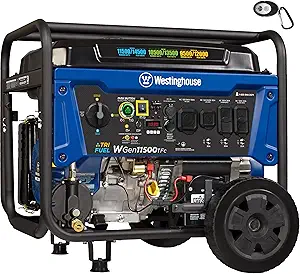
In an age where extreme weather, grid instability, and outdoor living are more common than ever, reliable backup power is not a luxury—it’s a necessity. Whether you’re preparing for emergency outages, powering a remote cabin, or ensuring you can run tools at a job site, having a tri-fuel portable generator gives you unmatched flexibility. These machines can run on gasoline, propane, or natural gas, offering adaptable fuel choices depending on availability, cost, and environmental preferences.
Unlike traditional single-fuel units, tri-fuel generators allow users to switch between fuels with ease, making them ideal for long-term use during natural disasters, RV trips, or even as semi-permanent power sources for off-grid homes. The models reviewed here offer high wattage, multiple safety features, transfer switch compatibility, and remote or electric starts, ensuring they meet the demands of both novice and professional users.
2025 Tri-Fuel Portable Generator
| Generator Model | Links |
|---|---|
| Westinghouse 14500 Peak Watt Tri-Fuel Generator | Check Amazon Price |
| DuroMax XP13000HXT 13,000-Watt Tri-Fuel Generator | Check Amazon Price |
| WEN 14500-Watt Tri-Fuel Generator | Check Amazon Price |
| Westinghouse 18000 Peak Watt Tri-Fuel Generator | Check Amazon Price |
| Generac 9500-Watt Tri-Fuel Portable Generator | Check Amazon Price |
Detailed Overview of Each Model
1. Westinghouse 14500 Peak Watt Tri-Fuel Generator
- Peak Wattage: 14,500
- Fuel Options: Gasoline, Propane, Natural Gas
- Features: This model includes remote start, is transfer switch ready, and offers an impressive 19-hour runtime on a full tank of gas.
- Best For: Extended power outages, whole-home backup.
- Strengths: The combination of power and long runtime makes it a great investment for users needing high performance with minimal refueling.
2. DuroMax XP13000HXT 13,000-Watt Tri-Fuel Generator
- Peak Wattage: 13,000
- Fuel Options: Gasoline, Propane, Natural Gas
- Features: Offers CO alert technology, a robust 500cc engine, and seamless tri-fuel transition.
- Best For: Mid-size homes, job sites, RVs.
- Strengths: Built for safety with advanced CO detection and built-in versatility for mobile or stationary power needs.
3. WEN 14500-Watt Tri-Fuel Generator
- Peak Wattage: 14,500
- Fuel Options: Gasoline, Propane, Natural Gas
- Features: Features electric start, CO watchdog, and transfer switch compatibility.
- Best For: Budget-conscious users needing robust backup power.
- Strengths: Reliable power without compromising on critical features. Ideal for homes and contractors alike.
4. Westinghouse 18000 Peak Watt Tri-Fuel Generator
- Peak Wattage: 18,000
- Fuel Options: Gasoline, Propane, Natural Gas
- Features: Includes remote start, CO detection, and a 10.57-gallon fuel tank for longer operation.
- Best For: Large homes, small businesses, agricultural operations.
- Strengths: One of the most powerful in its class. Capable of running central air conditioning and other energy-intensive appliances simultaneously.
5. Generac 9500-Watt Tri-Fuel Portable Generator
- Peak Wattage: 9,500
- Fuel Options: Gasoline, Propane, Natural Gas
- Features: Comes with electric start, COsense tech, and covered outlets for safety.
- Best For: Smaller homes, light-duty backup power.
- Strengths: Compact but powerful enough for essential appliances and electronics during emergencies.
Key Benefits of Tri-Fuel Generators
- Fuel Flexibility: Choose between the most cost-effective or readily available fuel in your area. If propane is cheaper than gasoline, or natural gas is already piped to your home, these units adapt seamlessly.
- Long-Term Value: Avoid fuel shortages during emergencies and disasters. This makes tri-fuel options significantly more reliable than single-fuel generators.
- Environmentally Friendly: Natural gas burns cleaner than gasoline and diesel, reducing your carbon footprint during extended usage.
- Increased Safety: Many of the models above include CO alert systems, transfer switch compatibility, and covered outlets, prioritizing user safety.
What to Consider Before Buying
1. Wattage Requirements
Determine the total wattage needed for your essential devices. If you need to power HVAC systems, fridges, and multiple electronics, aim for at least 14,000 watts of peak output.
2. Fuel Source Availability
Evaluate your location:
- Urban homes with natural gas lines may prefer that for convenience.
- Rural setups may rely more on propane or gasoline due to delivery access.
3. Run Time & Tank Capacity
A longer runtime reduces refueling frequency. The Westinghouse 14500 and 18000 models offer the best in this regard.
4. Portability
Even large generators should be movable. Look for built-in wheels, handles, and compact frame designs if you plan to transport them.
5. Safety Features
Prioritize carbon monoxide detection, automatic shut-off, and GFCI-protected outlets for the safest experience.
Final Thoughts
When it comes to preparing for unpredictable events or powering essential tools and electronics, a tri-fuel generator offers a level of security, flexibility, and performance unmatched by traditional single-fuel units. Each model in this guide has been chosen for its durability, fuel efficiency, safety, and reliability—with options that cater to both small households and large commercial needs.
As natural disasters and rolling blackouts continue to rise, investing in a top-rated tri-fuel portable generator is no longer just smart—it’s essential. Consider your wattage needs, fuel preferences, and safety requirements, and choose the model that will keep your home or job site running without interruption in 2025 and beyond.